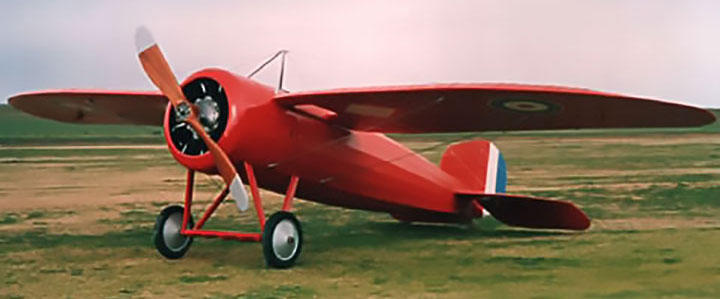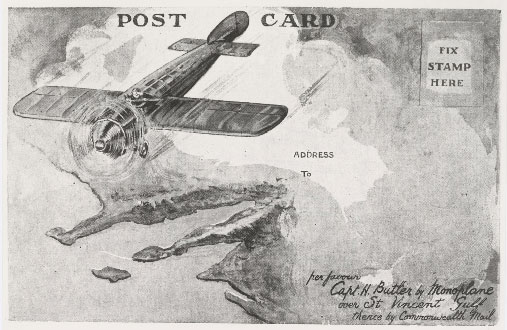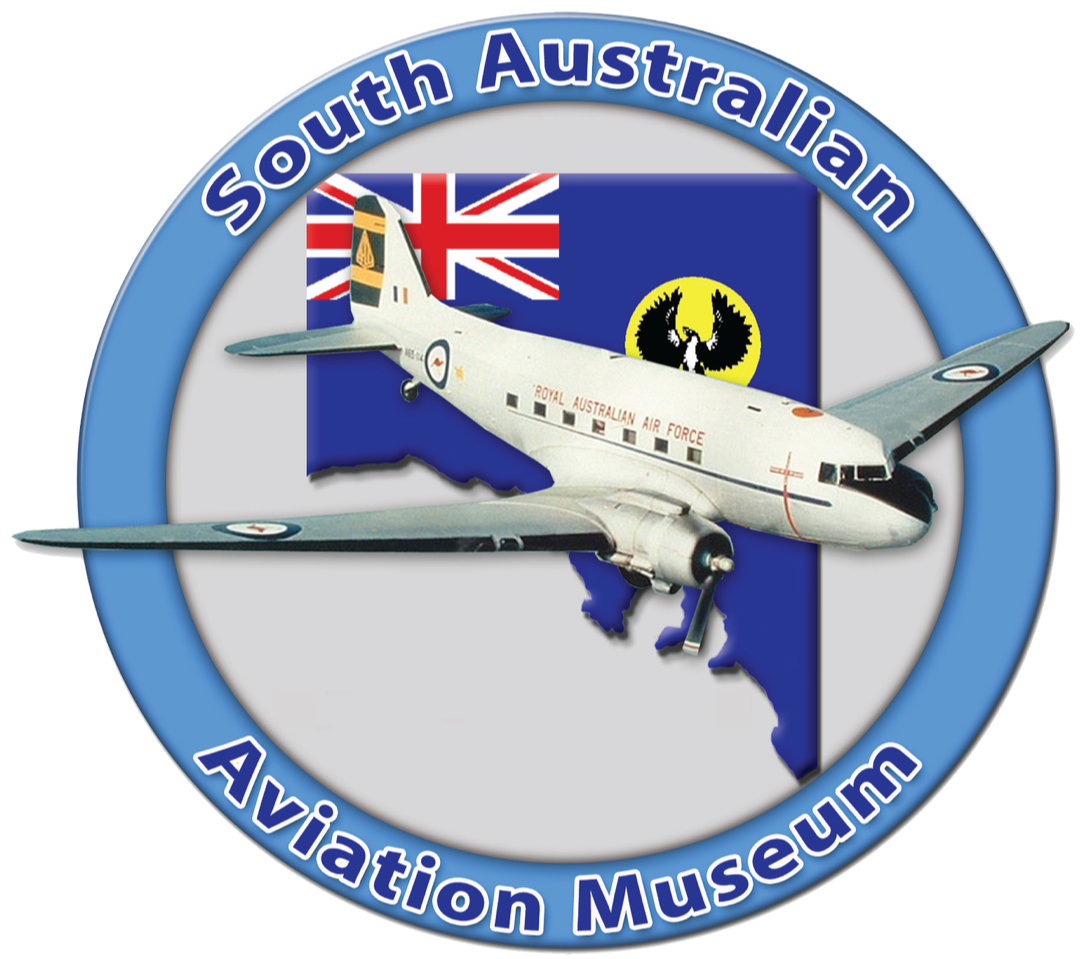The first commercial flight in Australia was on 6 August 1919, when Harry Butler carried the mail by air from Adelaide to his home town of Minlaton on the Yorke Peninsula. It was also the first commercial flight over sea in the Southern Hemisphere. The aircraft was a Bristol M.1C monoplane known as "the Red Devil". This aircraft is on display at Minlaton (York Peninsula) and is believed to be the only aeroplane of its type remaining in the world.

The Red Devil (on display at Minlaton)

A postcard form the flight (SAAM collection)
In August 1919 Butler and H.A. Kauper formed a company which they called The Harry Butler and Kauper Aviation Co Ltd. This company was formed at an air strip at Northfield in Adelaide. By October 1920 the company operated from an airfield at Albert Park, Adelaide, which Butler had purchased out of his own money.
Butler made his Northfield aerodrome available to the Smith Brothers for the arrival of their Vickers Vimy aircraft (G-EAOU) on the 23rd March 1920. This airfield was selected because it met the requirements for the personal safety of Ross Smith and his aircraft. It also had the necessary pre-requisites for controlling the massive crowds which attended his arrival. Butler's other airfield at Albert Park was deemed the best airfield available by the Civil Aviation Branch to become the site of the first Adelaide Commonwealth aerodrome. It was compulsory purchased on 5th July 1922 and later became the centre of aviation activity in the State.
On 11 January 1922, Butler crashed his plane near Minlaton. He was badly injured, but after he recovered he continued flying until 30 July 1924, when he died from a cerebral abscess.
SAAM Profile Captain Henry John BUTLER RFC 1889-1924
History of Parafield and Adelaide Airports .pdf
Horrie Miller
In 1919, Horrie Miller was working in Adelaide as a aircraft mechanic. In 1920, he took delivery of an Armstrong Whitworth war disposal aircraft and with Arthur Kennedy formed
The Commercial Aviation Company operating out of Parafield. In 1922 the partnership was dissolved and Miller sold the aircraft to Queensland and Northern Territory Aerial Services Ltd - it was one of the first two planes QANTAS owned.
In 1928, Miller joined with (Melbourne Based) philanthropist and confectioner MacPherson Robertson and established
MacRobertson Miller Airlines. In early 1934 the Adelaide based MacRobertson Miller Airlines won the contract for the Air Service between Perth and Wyndham including a route extention to Daly Waters N.T. to meet the mail plane to/from UK. The Adelade operations of MMA ceased in 1939, but the company continued in Perth. MacRobertson Miller Airlines was taken over by Ansett Airlines in 1963.
Australian Aerial Services Ltd. were operating from Parafield by early 1928. Western Australian Airlines opened an Adelaide-Perth service out of Parafield in 1929. Eyre Peninsula Airways operated out of Parafield from 1931. In 1936, Australian National Airways (ANA) operated flights between Adelaide, Perth, Melbourne and Sydney from Parafield.
Guinea Airways
In 1926, in Adelaide, C.J. Levien and C.V.T. Wells formed a gold mining company called 'Guinea Gold No Liability' with the intention of mining in the Bulolo area of New Guinea. They decided that aircraft would be used to overcome the transport difficulties in supplying their mine in the difficult terrain. On April 18th, 1927 it flew with its first passenger from Lae to the gold fields. The journey, which had previously taken 10 days on foot had been accomplished in only 45 minutes.
Guinea Airways was formed on 4th November, 1927 as a separate company to carry freight as part its parent company's gold-mining operations in New Guinea. During the next few years the company was to become the world's leading freight operator, carrying huge loads by 1930 standards, including complete motor cars. Guinea Airways could carry about 16 tonnes a day and carried more freight in one month than all other aircraft in the world actually carried in one year.
In February 1937, Guinea Airways commenced a weekly service between Adelaide and Darwin and won the Royal Mail Darwin/Adelaide trunk route in 1938. SAAM's Gipsy Moth VH-ULJ was used in the Buolo goldfields in New Guinea and in 1937, it was transferred to Guinea Airways and based at Lae. In January 1942, the Japanese bombed the company's headquarters at Lae, and they lost the bulk of the fleet of 15 aircraft. In February 1942, Gipsy Moth VH-ULJ was flown from Wau (New Guinea) to Parafield via Daru, Horn Island and Townsville to escape the Japanese invasion of New Guinea.
After the war, Guinea Airways was unable to return to operations in New Guinea and, with most of their fleet lost in the war, the profitable Adelaide/Darwin service was taken away and passed on to Trans Australian Airlines (TAA). Guinea began cooperating as a junior partner with Australian National Airways(ANA). Merger proposals submitted by Australian National Airways were rejected by shareholders, although ANA virtually became managing agents. Ansett Transport Industries Limited (ATI) acquired ANA and so Guinea made an arrangement with TAA on 1st July, 1958 to receive the services previously made available by ANA. This led to a successful take over offer on the 1st July, 1959 by ATI (Ansett). Guinea Airways became Airlines of S.A. (ASA) on 17th January 1960.
Airlines of S.A.
Airlines of South Australia (ASA) first flew on 18 January 1960 providing services from Adelaide to Port Lincoln, Minnipa, Ceduna, Cowell, Cleve, Kimba, Radium Hill, Broken Hill, Kangaroo Island, Port Pirie, Whyalla, Renmark, Mildura and Woomera. These routes had previously been serviced by Guinea Airways, which had been purchased by Ansett in 1959. ASA took over the Guinea Airways existing fleet of five DC-3s and an Auster, and added a 52-seat Convair 440 VH-BZH.
Throughout the 1960s, services were briefly added to Naracoorte, Millicent and tours to Hayman Island, Queensland from Adelaide while several initial services were progressively discontinued. A Piaggio P166 and a Fokker F27 Friendship (the first of several) replaced older aircraft. Airlines of S.A. were taken over by Ansett on the 28th June, 1986.
SAAM's Commercial Aviation Displays
SAAM's Commercial Aviation Display showcases a selection of Ansett, Qantas, Airlines of South Australia, Kendell, Virgin, and TAA Memorabilia an aircraft models. There are also several other larger scale models on display above the glass cabinet.
A recent addition to SAAM's Commercial Aircraft displays is the forward fuselage of the Cobham British Aerospace BAe 146-300 Short Haul Regional Jet Airliner. This aircraft (section) has been restored to provide an interactive exhibit where visitors will be able see the cabin as it was in use.








